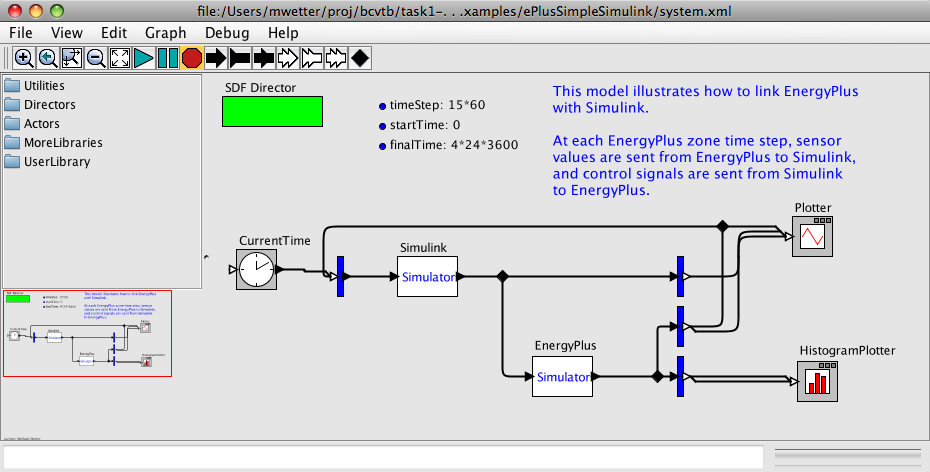|
Size: 4106
Comment:
|
Size: 4124
Comment:
|
| Deletions are marked like this. | Additions are marked like this. |
| Line 23: | Line 23: |
| The coupling of Modelica allows using !EnergyPlus for modeling the building heat flow and daylight availability and using Modelica to model innovative building energy and control systems based on the library that is currently in development at https://gaia.lbl.gov/bir. This allows advanced users to | The coupling of Modelica allows using !EnergyPlus for modeling the building heat flow and daylight availability and using Modelica to model innovative building energy and control systems based on the library that is currently in development at http://simulationresearch.lbl.gov/modelica. This allows advanced users to |
Building Controls Virtual Test Bed
|
The Building Controls Virtual Test Bed (BCVTB) is a software environment that allows expert users to couple different simulation programs for distributed simulation. For example, the BCVTB allows to simulate a building and HVAC system in EnergyPlus and the control logic in MATLAB/Simulink, while exchanging data between the software as they simulate. The BCVTB is based on the Ptolemy II software environment. The BCVTB is still under development and aimed at expert users of simulation. Due to the different programs that may be involved in distributed simulation, familiarity with compiling and configuring programs is essential.
Programs that are linked to the BCVTB are
In future work we will link a BACnet compliant Building Automation System (BAS) and digital/analog converters to the BCVTB. In addition to using programs that are coupled to Ptolemy II, Ptolemy II's graphical modeling environment can also be used to define models for control systems, for physical devices, for communication systems or for post-processing and real-time visualization.
Typical applications of the BCVTB include:
- performance assessment of integrated building energy and controls systems,
- development of new controls algorithms, and
- formal verification of controls algorithms prior to deployment in a building in order to reduce commissioning time.
The coupling of Modelica allows using EnergyPlus for modeling the building heat flow and daylight availability and using Modelica to model innovative building energy and control systems based on the library that is currently in development at http://simulationresearch.lbl.gov/modelica. This allows advanced users to
define on the fly new HVAC components and systems in a modular, hierarchical, object-oriented, equation-based graphical modeling environment and couple them to EnergyPlus,
- innovate new HVAC system and control architectures for which models do not yet exist in off-the-shelve building simulation programs, and
- analyze dynamic effects of HVAC systems, modeled in Modelica, and their local and supervisory control loops, modeled in MATLAB/Simulink, Modelica or Ptolemy.
In future work, we will couple a BACnet compliant Building Automation System to the BCVTB. This will allow testing supervisory control sequences using an EnergyPlus model to assess the energy and comfort performance of different supervisory control algorithms. It will also allow formal verification of control sequences before deployment to a building.
Contact
Michael Wetter and Philip Haves
Lawrence Berkeley National Laboratory
Building Technologies Department
{MWetter,PHaves}@lbl.gov
Acknowledgements
This research was supported by the Assistant Secretary for Energy Efficiency and Renewable Energy, Office of Building Technologies of the U.S. Department of Energy, under Contract No. DE-AC02-05CH11231.
We would also like to thank
University of Colorado at Boulder (Gregor Henze, Charles Corbin, Anthony Florita and Peter May-Ostendorp) for their contributions to the MATLAB interface and the EnergyPlus 3.0 upgrade, and
Rui Zhang from Carnegie Mellon for her contributions to the Windows configuration and the EnergyPlus 3.1 upgrade.
